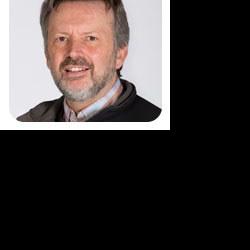Biography
(from Wikipedia)
David Hodell is a marine geologist and paleoclimatologist. He currently holds the position of Woodwardian Professor of Geology in the Department of Earth Sciences, University of Cambridge, where he is also a fellow of Clare College. He is the current Director of the Godwin Laboratory for Palaeoclimate Research. Previously, he taught at the University of Florida from 1986–2008, earning the rank of full professor in geological sciences. Hodell was also the director of the Stable Isotope Laboratory from 1996–2008. Hodell earned his Ph.D. in 1986 in oceanography from the Graduate School of Oceanography, University of Rhode Island, after earning his bachelor of arts in 1980 in geology from the University of Vermont. In 2007, he was elected a fellow of the American Geophysical Union. He became a recipient of the Milutin Milankovic Medal in 2018 and was elected as a fellow to the American Association for the Advancement of Science (AAAS) in 2020.
Research
Palaeo-climatology, -oceanography and -limnology.
My research focuses on high-resolution paleoclimate records from marine and lacustrine sediments and, more recently, speleothems to better understand past climate dynamics. Field programs involve recovering sediment cores from selected lakes and ocean basins throughout the world and range from simple missions utilizing inflatable boats and hand-operated coring equipment to complex campaigns that utilize oceanic research vessels or lake drilling platforms. For the latter, I am actively involved the Integrated Ocean Drilling Program (IODP) and International Continental Drilling Program (ICDP). My research using deep-sea sediments has been concentrated geographically on the North and South Atlantic Oceans, with the aim of integrating marine sediment and ice core records. The objective is to build marine sediment analogs to the polar ice cores to study ocean-atmosphere linkages and the relative timing, phasing, and interhemispheric coupling mechanisms of climate change between the polar regions. My work using lake sediment cores and speleothems is centered in Mesoamerica, Cambodia and India. The objective is to reconstruct Holocene climate change and, specifically, to explore how climate change may have affected ancient civilisations such as the Maya, Khmer and Indus Valley.
Current research projects include:
- Nature and origin of suborbital climate variability on the Iberian Margin during the late Pliocene and Quaternary
- Ice sheet dynamics and abrupt change
- Water isotopes in hydrated minerals
- The role of the Southern Ocean in global carbon cycling and climate change
- Climate change in the lowland Neotropics during the last glacial-to-interglacial cycle
- Human-climate-environment interactions
IODP Expedition 397 sites drilled on the Iberian Margin including Site U1385 ("Shackleton site").
• Nature and origin of suborbital climate variability on the Iberian Margin during the Pleistocene
The polar ice cores have provided unrivaled records of climate change that have become benchmarks for late Pleistocene climate variability; however, the oldest continuous ice cores recovered to date in Greenland and Antarctica is ~124 and 800 ka, respectively. An important challenge for the paleoceanographic community is to identify complementary marine sections with sufficiently high sedimentation rates and climate signals suitable for comparison with the polar ice core records. One such area is the rapidly accumulating sediments on the South West Iberian Margin, which provide high-fidelity records of millennial-scale climate variability that can be correlated precisely to the polar ice cores.
During IODP Expedition 339 in 2011 and Expedition 397 in 2022, we drilled ten holes at Site U1385 ("Shackleton site") reaching a total of ~400 m below sea floor. The prime objective of IODP Site U1385 was to extend the piston core records from the SW Iberian Margin and provide a continuous marine record of Plio-Pleistocene millennial climate variability that can be correlated to polar ice cores and European terrestrial sequences. It offers an unprecedented opportunity to study the interaction between shorter (millennial) and longer (orbital) climate variability to better understand the observed patterns of Quaternary glacial–interglacial cycles.
Hodell, D., Crowhurst, S., Lourens, L., Margari, V., Nicolson, J., Rolfe, J. E., Skinner, L. C., Thomas, N., Tzedakis, P. C., Mleneck-Vautravers, M. J., and Wolff, E. W.: A 1.5-Million-Year Record of Orbital and Millennial Climate Variability in the North Atlantic, Clim. Past Discuss. [preprint], https://doi.org/10.5194/cp-2022-61, in review, 2022.
Birner, B., Hodell, D.A., Tzedakis, P.C., and Skinner, L.C., 2016. Similar millennial climate variability on the Iberian Margin during two early Pleistocene glacials and MIS 3. Paleoceanography, 31, 203-217.
Hodell, D. A., L. Lourens, S. J. Crowhurst, T. Konijnendijk, R. Tjallingii, F. Jimenez-Espejo, L. C. Skinner, P. C. Tzedakis, and Members of the Shackleton Site Project, 2015. A reference time scale for Site U1385 (Shackleton Site) on the Iberian Margin, Global Planetary Change, 133: 49-64, doi:10.1016/j.gloplacha.2015.07.002.
Hodell, D.A.,Lourens, L., Stow, D. A. V., Hernández-Molina, J., Alvarez Zarikian, C. A., and the Shackleton Site Project Members, 2013. The “Shackleton Site” (IODP Site U1385) on the Iberian Margin, Scientific Drilling, 16, 13–19.
Hodell, D.A., Crowhurst, S., Skinner, L., Tzedakis, P.C., Margari, V., Channell, J.E.T., Kamenov, G., Maclachlan, S., and Rothwell, G., 2013. Response of Iberian Margin sediments to orbital and suborbital forcing over the past 420 ka. Paleoceanography, 28, 1–15, doi:10.1002/palo.20017.
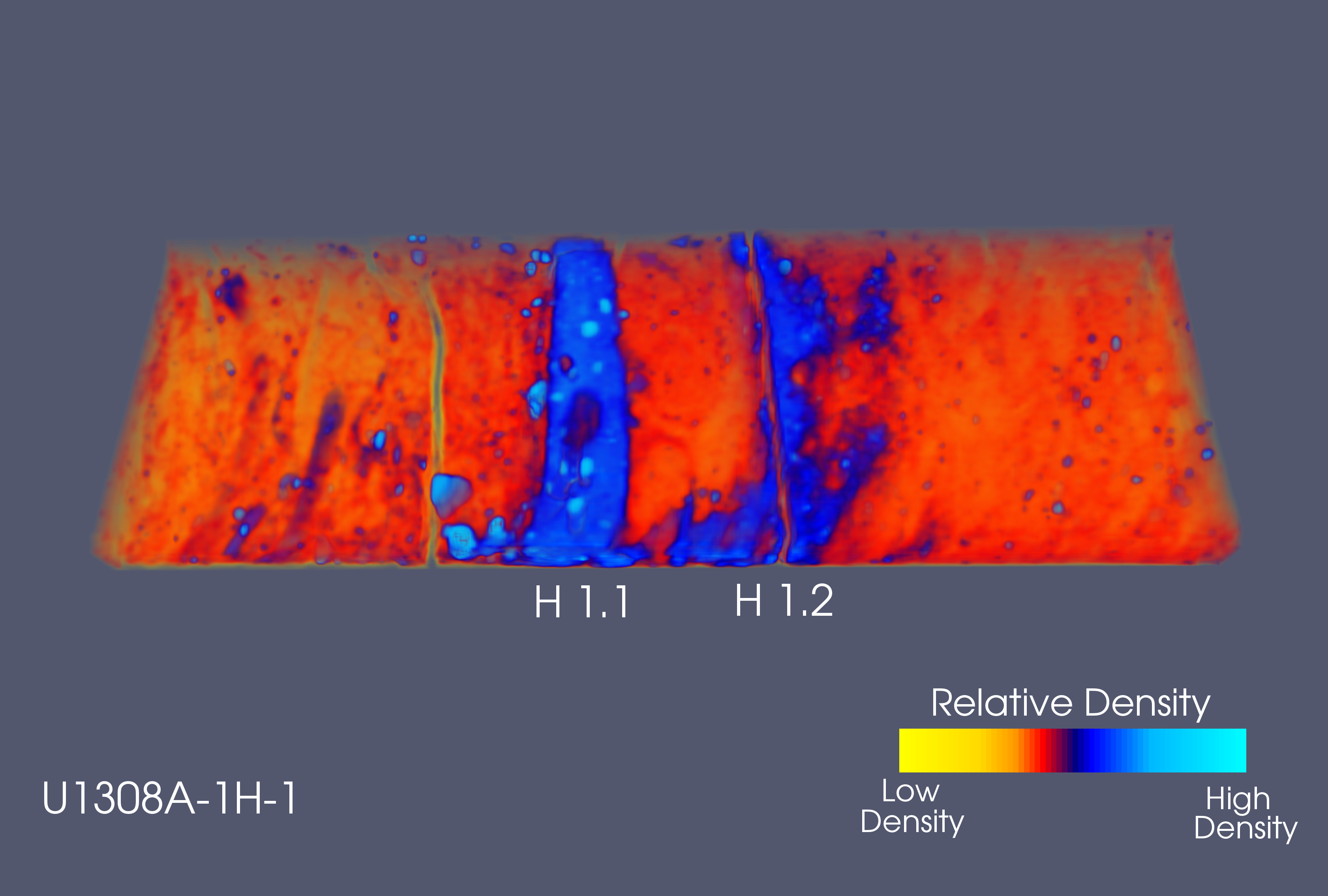
X-ray CT (computed tomography) image of Heinrich Event 1 in Hole U1308A showing two distinct layers of ice-rafted detritus.
The buildup of ice on Northern Hemisphere continents can be thought of as a “capacitor” that stores freshwater on land during times of ice growth and releases it to the ocean during times of ice decay as icebergs and meltwater . The volume, rate, and location of freshwater discharge to the North Atlantic Ocean relative to the source areas of deepwater formation can have a strong impact on Earth’s global climate. As ice sheets grew larger during glacial periods of the Quaternary, the freshwater capacitor became more highly charged and the potential for strong climate response upon discharge was enhanced. I am interested in how orbital and millennial climate variability evolved during the Quaternary as ice sheets grew larger and the style, frequency and intensity of millennial-scale variability changed.
Hodell, D.A., Nicholl, J.A., Bontognali, T.R.R., Danino, S., Droador, J., Dowdeswell, J.A., Einsle, J., Kuhlmann, H., Martrat, B., Mleneck-Vautravers, M.J., Rodriguez-Tovar, F., and Röhl, J., 2017. Anatomy of Heinrich Layer 1 and its Role in the Last Deglaciation, Paleoceanography. 32, doi:10.1002/2016PA003028.
Hodell, D. A. and Channell, J. E. T., 2016. Mode transitions in Northern Hemisphere Glaciation: Co-evolution of millennial and orbital variability in Quaternary climate, Clim. Past, 12, 1805-1828.
Obrochta, S.P., Crowley, T.J., Channell, J.E.T., Hodell, D.A., Baker, P.A., Seki, A., Yokoyama, Y., 2014. Climate variability and ice-sheet dynamics during the last three glaciations, Earth and Planetary Science Letters. 406, 198-212, http://dx.doi.org/10.1016/jepsl.2014.09.0004
Hodell, D.A., Channell, J.E.T., Curtis, J., Romero, O., and Roehl, U., 2008.
Onset of “Hudson Strait” Heinrich Events in the Eastern North Atlantic at the end of the Middle Pleistocene Transition (~640 ka)?, Paleoceanography, 23, doi:10.1029/2008PA001591.
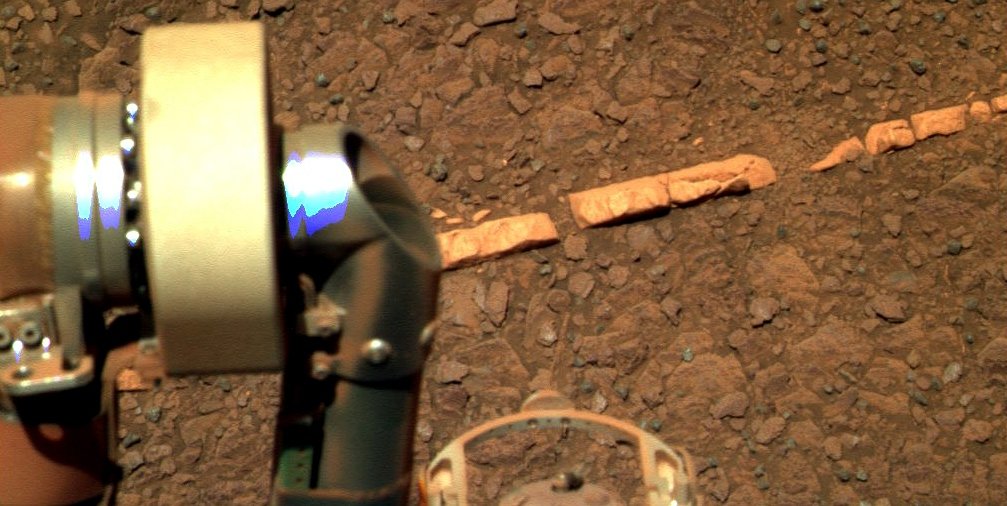
The "Homestake" gypsum vein on Mars taken by the Opportunity rover (photo credit: NASA)
•Water isotopes in hydrated minerals
Water is fundamental to life as we know it, and the current strategy for the search of life on Mars is to “follow the water”. Much of the water on Mars exists today in the form of hydrated minerals that incorporate molecular water or hydroxyl into their crystalline structure. Hydrated minerals provide a tool for studying the past history of the hydrosphere on Mars as well as Earth. Oxygen and hydrogen isotopes of hydration water in minerals record information about the conditions under which hydrated minerals form and subsequently interact with fluids after deposition. We have developed a new analytical approach to measure the isotope composition of hydration water in minerals and mineraloids using differential thermal isotope analysis. The approach involves interfacing a thermal gravimeter (TG) and differential scanning calorimeter (DSC) with a laser-based water isotope analyzer. This allows us to to separate the various forms of water in a mineral (absorbed, molecular, hydroxyl) by step heating in small increments whilst simultaneously measuring oxygen and hydrogen isotope ratios.
I direct a five-year ERC Advanced project to study the nature of water isotopes in hydrated minerals, including gypsum, clays, opal, etc. Questions being addressed include: (1) how many different types of hydration states of water are present and how they are fixed into the mineral structure; (2) how the isotopic composition varies among the differently bound water in minerals; (3) how the type of bonding of water in minerals affects the rate of isotopic exchange with external water; and (4) whether or not any of the hydration water has retained its isotopic composition from the time of formation. The project includes both a theoretical (ab initio simulations) and empirical approach that has the potential to transform our understanding of mineral hydration water and its isotopic composition. The research has wide ranging application for addressing fundamental problems across many disciplines in Earth and Planetary Sciences, including: palaeoclimatology, sedimentology (clay mineralogy, evaporites), volcanology, water exchange between the solid earth and hydrosphere, and water on Mars and other planetary bodies.
Gázquez, F., Evans, N.P., and Hodell, D.A., 2017. Precise and accurate isotope fractionation factors (α17O, α18O and αD) for water and CaSO4·2H2O (gypsum). Geochim. Cosmochim. Acta. 198, 259–270.
Gázquez, F., Mather, I., Rolfe, J., Evans, N.P., Herwartz, D., Staubwasser, M., Hodell, D.A., 2015. Simultaneous analysis of 17O/16O, 18O/16O and 2H/1H of gypsum hydration water by cavity ringdown laser spectroscopy. Rapid Communications in Mass Spectrometry, 29, 1997–2006.
Evans, N.P., Turchyn, A.V., Gázquez, F., Bontognali, T.R.R., Chapman, H.J., and Hodell, D.A., 2015. Coupled measurements of δ18O and δD of hydration water and salinity of fluid inclusions in gypsum from the Messinian Yesares Member, Sorbas Basin (SE Spain). Earth Planet. Sci. Letts., 430, 499–510.
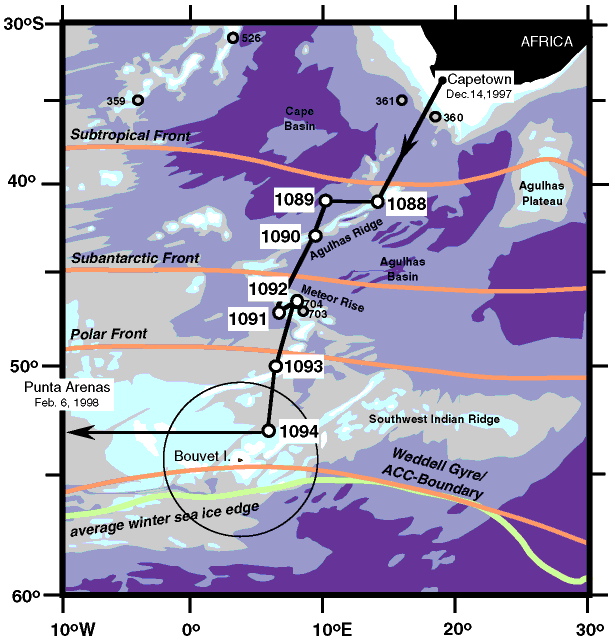
IODP Expedition 177 recovered an invaluable archive of sediment cores from the South Atlantic sector of the Southern Ocean.
Paleoceanographers have recognized that processes occurring in the Southern Ocean have played a vital role in defining Earth's climate. For example, changes in Antarctic surface conditions and deep-water ventilation play an important role in controlling past changes in atmospheric CO2. Yet the amount of existing paleoceanographic data from the Southern Ocean is not nearly commensurate with the climatic importance of this region as a whole. Compared to other regions, the Southern Ocean has relatively few deep-sea cores that are suitable for high-resolution paleoclimatic work. My research has specifically targeted areas of high sedimentation rates in the South Atlantic sector of the Southern Ocean. Depsite being collected twenty years ago, cores collected during IODP Expedition 177 continute to be an invaluable source of sediments with which to study Southern Ocean processes. Results have provided support for both a physical and biological cause of glacial-to-interglacial CO2 variation that involved Antarctic surface water processes (sea ice, surface stratification, productivity) and ventilation of deep water in the Southern Ocean, followed by a secondary response of the marine carbonate system.
Hodell, D.A., and Venz-Curtis, K.A., Late Neogene History of Deepwater Ventilation in the Southern Ocean, 2006. Geochemistry Geophysics Geosystems, 7, Q09001, doi:10.1029/2005GC001211.
Martinez-Garcia, A., Sigman, D.M., Ren, H., Anderson, R.F., Straub, M., Hodell, D.A., Jaccard, S.L., Eglinton, T.I., and Haug, G.H., 2014. Iron fertilization of the Subantarctic Ocean during the last ice age. Science, 343, 1347-1350.
Jaccard, S. L., Hayes, C.T., Martinez-Garcia, A. , Hodell, D.A., Anderson, R.F., Sigman, D.M., and Haug, G.H., 2013. Two modes of change in Southern Ocean productivity over the past million years. Science 339, 1419-1423.
Hayes, C.T., Martinez-Garcia, A., Hasenfratz, A.P., Jaccard, S.L., Hodell, D.A., Sigman, D.M., Haug, G.H., and Anderson, R.F., 2014. A stagnation event in the deep South Atlantic during the last interglacial period. Science, 346, 1514-1517.
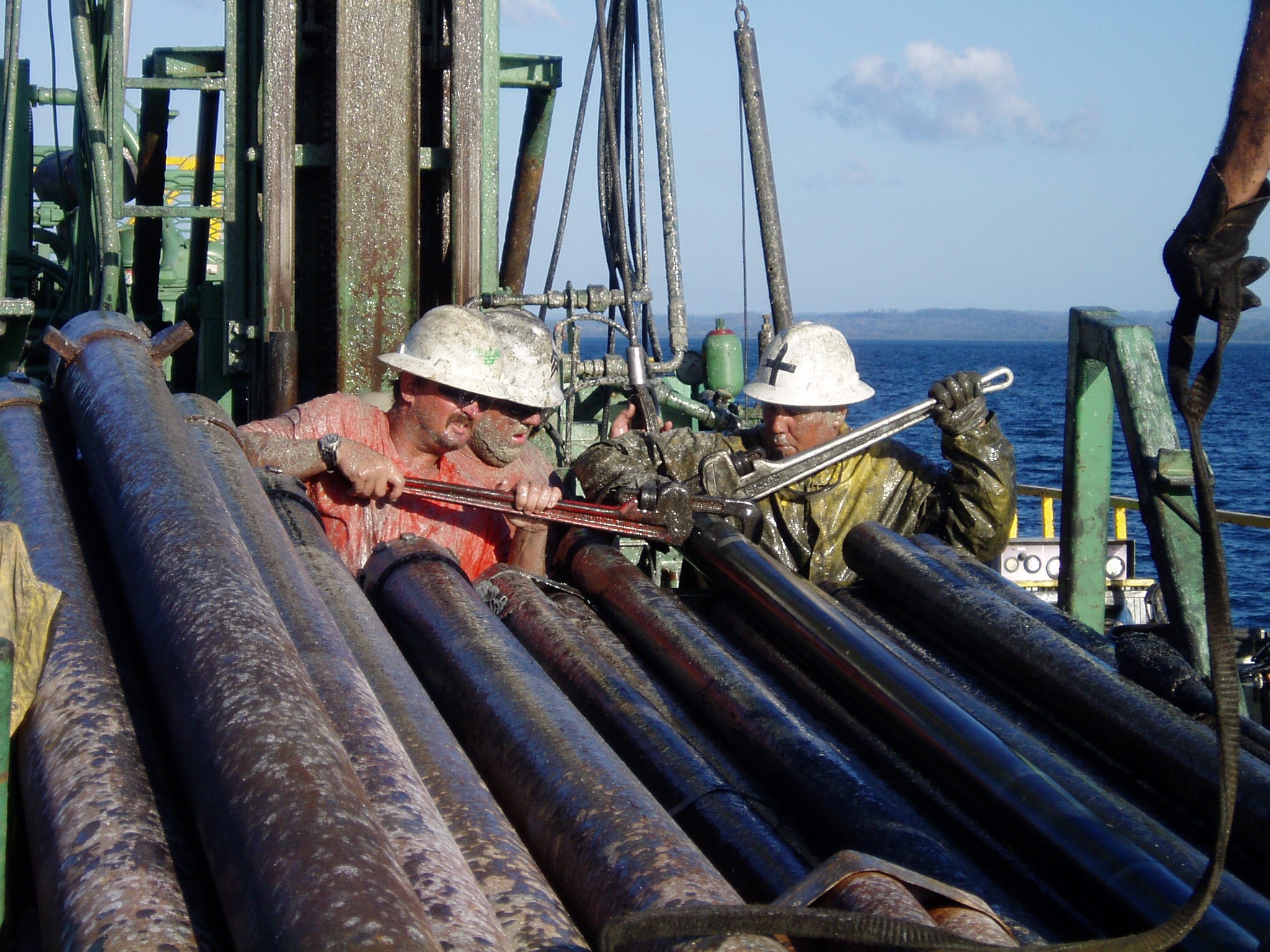
ICDP drilling of Lake Peten-Itza, Guatemala, using the GLAD 800 drilling platform (R/V Kerry Kelts)
• Climate change in the lowland Neotropics during the last glacial-to-interglacial cycle
Paleoclimatologists and modelers have increasingly focused on the tropics as a potentially important driver of global climate change because of the region's role in the Earth's energy budget and in regulating the water vapor content of the atmosphere. Tropical climate change is often expressed as variations in precipitation, as opposed to temperature changes that are more pronounced at higher latitudes. Tropical closed-basin lakes are sensitive recorders of changes in balance between precipitation and evaporation, and drilling technology now offers the opportunity to obtain long continuous sediment records from deep lake basins. Using the GLAD800 drilling platform (R/V Kerry Kelts), we recovered 1327 meters of continuous, high-quality sediment cores from Lake Peten-Itza, Guatemala. The overall objective is to decipher the history of the northern hemisphere Neotropical hydrologic cycle during the last glacial cycle, its relation to changes in the position of the Atlantic Intertropical Convergence Zone (ITCZ), and linkages to climate variability in the high-latitude North Atlantic. Marine-terrestrial linkages will be established by correlating rainfall/runoff proxies in sediment cores from Lake Peten-Itza with those from the nearby Cariaco Basin, northern Venezuela, to determine regional precipitation changes. In turn, the Peten-Itza record will be compared with proxy signals from the high latitudes of the North Atlantic to assess linkages with that region. The aim is to test our working hypothesis that past changes in lowland northern Neotropical precipitation were related to the meridional displacements in the mean position of the Atlantic ITCZ.
Hodell, D.A., Turchyn, A.V., Wiseman, C.J., Escobar, J., Curtis, J.H., Brenner, M., Gilli, A., Mueller, A.D., Anselmetti, F., Ariztegui, D., and Brown, E., 2012. Late Glacial temperature and precipitation changes in the lowland Neotropics by tandem measurement of δ18O in biogenic carbonate and gypsum hydration water. Geochimica et Cosmochimica Acta 77, 352-368.
Hodell, D.A., Anselmetti, F.S., Ariztegui, D., Brenner, M., Curtis, J.H., Gilli, A., Grzesik, D.A., Guilderson, T.J., Muller, A.D., Bush, M.B., Correa-Metrio, Y.A., Escobar, J., and Kutterolf, S., 2008. An 85-ka Record of Climate Change in Lowland Central America, Quaternary Science Reviews, 27, 1152- 1165.
Hodell, D.A., Anselmetti, F., Brenner, M., Ariztegi, D., and the PISDP Scientific Party, The Lake Peten Itza Scientific Drilling Project, Scientific Drilling, 3, 25-29, doi:10.2204/iodp.sd.3.02.2006.
Grauel, A.- L., Hodell, D.A., and Bernasconi, S.M., 2016. Quantitative estimates of tropical temperature change in lowland Central America during the last 42ka. Earth Planet. Sci. Letts., 438, 37-46.
Mays, J.L., Brenner, M., Curtis, J.H., Curtis, K.V., Hodell, D.A., Correa-Metrio, A., Escobar, J., Dutton, A.L., Zimmerman, A.R., and Guilderson, T.P., 2017. Stable carbon isotopes (δ13C) of total organic carbon and long-chain n-alkanes as proxies for climate and environmental change in a sediment core from Lake Petén-Itzá, Guatemala, Journal of Paleolimnology, 57: 307.
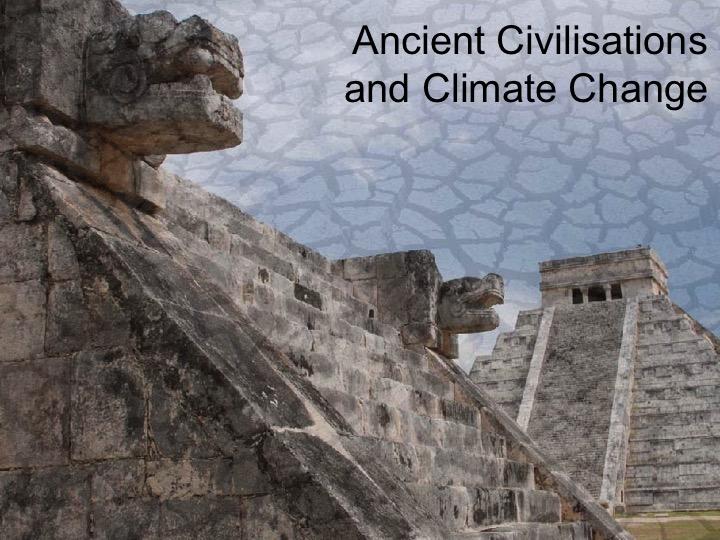
• Human-climate-environment interactions
Our society is increasingly interested in the consequences of future climate and environmental change, as well as the role that humans play in these changes. Human civilizations throughout history have affected the environment and perhaps influenced climate through deforestation, agriculture, urbanization and industrialization. I have had a longstanding interest in how ancient civilizations affected their environment and, in turn, how environmental and climate change may have influenced cultural evolution. My work has been focused mainly on the Maya civilisation of Mesoamerica and, more recently, the Indus Valley civilisation of India. Research continues documenting the history of climate change on the Yucatan Peninsula using lake sediments and speleothems and its role in the demise of the Maya Civilization during the Terminal Classic Period. Together with Cameron Petrie in the Department of Anthropology and Archaeology (Cambridge), I am involved in the ERC-funded "Two Rains" project to investigate the climate history and dynamics of winter and summer rainfall systems in NW India and its potential impact on the Bronze Age Indus Civilisation.
Hodell, D.A., 2011. Maya Megadrought?. Nature (News&Views) 479, 45.
Dixit, Y., Hodell, D.A., Petrie, C.A., and Sinha, R., 2014. Abrupt weakening of the Indian summer monsoon at 8.2 kyr B.P. Earth Planet. Sci. Letts., 391, 16-23.
Dixit, Y., Hodell, D.A., and Petrie, C.A., 2014. Abrupt weakening of the summer monsoon in northwest India ~4100 years ago. Geology, 42(4), 339-342.
Petrie, C.A., Singh, R.N., Bates, J., Dixit, Y., French, C.A.I., Hodell, D.A., Jones, P.J., Lancelotti, C., Lynam, F., Neogi., S., Pandey, A.K., Parikh, D., Pawar, V., Redhouse, D.I., and Singh, D.P., 2017. Adaptation to Variable Environments, Resilience to Climate Change: Investigating Land, Water and Settlement in Indus Northwest India, Current Anthropology, 58(1), 1-30.
Publications
List of publications can be found here.


